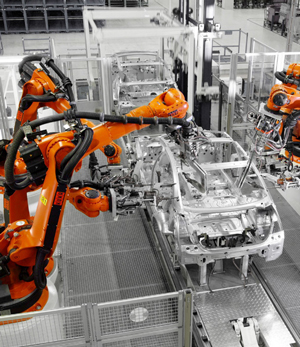THANK YOU FOR SUBSCRIBING
Editor's Pick (1 - 4 of 8)

The Role of Automation in the Automotive Industry
Dana Burch, Industry Sales Director, Auto, Tire, and Electric Vehicle, Asia Pacific, Rockwell Automation


Dana Burch, Industry Sales Director, Auto, Tire, and Electric Vehicle, Asia Pacific, Rockwell Automation
 Automated analytics
The integration of equipment and machine analytics can help convert raw data into actionable insights to improve efficiencies and realise a faster time to market. Analytics can also enable automakers to proactively plan and schedule maintenance, allowing them to gain greater control over their production environment.
As many existing analytics technologies require deep expertise in both data science and industrial processes, automakers are turning to embedded analytics modules equipped with artificial intelligence (AI), which can apply machine learning concepts without the need for a data scientist. Such modules canpredict production anomalies like an overheating engine or a faulty drive and alert workers, so they can intervene as necessary.
Manufacturing Execution System (MES)
Manufacturing execution system (MES) software can help auto manufacturers achieve more efficient production, better material coordination, react faster to market changesand improve quality management through three key functionalities: operations management, information management and an integration gateway.
Operations Management: An MES can help auto manufacturers better coordinate the full spectrum of production operations for both build-to-stock and build-to-order manufacturing. This includes synchronizing production activities; improving work-instruction delivery to plant personnel in increasingly complex flexible-manufacturing operations; and better management of the flow of materials from warehouses and suppliers.
Automated analytics
The integration of equipment and machine analytics can help convert raw data into actionable insights to improve efficiencies and realise a faster time to market. Analytics can also enable automakers to proactively plan and schedule maintenance, allowing them to gain greater control over their production environment.
As many existing analytics technologies require deep expertise in both data science and industrial processes, automakers are turning to embedded analytics modules equipped with artificial intelligence (AI), which can apply machine learning concepts without the need for a data scientist. Such modules canpredict production anomalies like an overheating engine or a faulty drive and alert workers, so they can intervene as necessary.
Manufacturing Execution System (MES)
Manufacturing execution system (MES) software can help auto manufacturers achieve more efficient production, better material coordination, react faster to market changesand improve quality management through three key functionalities: operations management, information management and an integration gateway.
Operations Management: An MES can help auto manufacturers better coordinate the full spectrum of production operations for both build-to-stock and build-to-order manufacturing. This includes synchronizing production activities; improving work-instruction delivery to plant personnel in increasingly complex flexible-manufacturing operations; and better management of the flow of materials from warehouses and suppliers. Information Management: Automating data collection in an MES can replace costly, time-consuming and potentially error-prone manual data collection. Data can be displayed in dashboards and as KPIs for better decision making and consistent performance measurement. Production data can also be used for regulatory compliance and warranties, while genealogy and traceability can help limit the scope of recalls and shorten containment response times.
Integration Gateway: An MES also enables integration between plant-floor and business networks. This is the key to bridging historically separate information technology (IT) and operations technology (OT) systems to create The Connected Enterprise – a unified network architecture that connects the people, processes and technologies across the entire organization, to shorten time-to-market, lower total cost of ownership, improve asset utilisation, drive plant-floor efficiencies and enhance enterprise risk management.
Augmented Reality
Automotive manufacturing consists of hundreds and even thousands of steps, andwith the business’ bottom-line at stake,it is critical to help to ensure that there are no mistakes in between.
Augmented reality (AR) delivers more efficient and effective ways of looking at digital information within the physical world. In factories, data from automation and control systems, secondary sensors, and asset management systems are collected and represented as a digital twin, a 3D virtual real-time representation of the physical systemswhich includes important monitoring and diagnostic data about each machine or process. Workers can check on the actual workings and real-time performance data of the physical systems remotely, reducing manpower costs.
By attaching relevant information to the physical location where it will be best observed and understood, AR interfaces deliver just the right information the moment it’s needed to factory workers on assembly lines, reducing errors, enhancing efficiency, and improving productivity.
Intelligent Conveyance
In a typical automotive assembly plant, chain conveyors, roller-beds and skillet conveyors often run at fixed speeds and pitch, and theconveyance system is continuously consuming electricity and cannot accelerate, decelerate and precisely position a specific chassis to save time and energy. While some conventional systems may allow for variation in pitch or distance between the movers, in many situations that distance cannot be easily modified to accommodate multiple model types within one assembly line.
In addition, traditional conveyers are complex and made up of hundreds of wear components.These large, complicated solutions are not only difficult to modify but also prone to maintenance and costly downtime. The rotary motor technology used in conventional friction-based transfer systems also add inertia in linear applicationsand limit improvements in speed and acceleration.
New advances in independent cart conveyance – based on linear motor technology – are enabling significant performance gains.By enabling the end-to-end configuration of conveyor modules, anelectro-magnetic force iscreated whichpropels carriers at a much faster rate than traditional systems.And because linear motors have no contacting or wear components, maintenance is minimal.
Apart from linear motors, intelligent motion control is also the key to improved productivity, flexibility and sustainability. One of the latest innovations in the field is a “pitchless” carrier conveyance system that’s more energy efficient and 30 percent faster than conventional friction-based transfer systems. Manufacturers can program accelerations, decelerations, velocities and positions depending on the unique needs of their assembly line, allowing for greater use of industrial robots and other process equipment, making the overall system footprint much smaller than traditional systems.
Analytics, MES software, AR and intelligent conveyance are the bread-and-butter of efficient, scalable and flexible automotive manufacturing. These technology advancements allow auto manufacturers to improve quality, productivity, energy efficiency and responsiveness to market demands while reducingsystem complexity, potential points of failure and downtime, all of which are critical to a business’ bottom line.
Auto manufacturers who wish to harness the full potential of their supply chain can considerutilising solutions like these, which are not only scalable and customisable but also provide the foundation for future enhancements,allowingthem to adapt quickly to industry challenges andopportunities.
Weekly Brief
I agree We use cookies on this website to enhance your user experience. By clicking any link on this page you are giving your consent for us to set cookies. More info
Read Also













